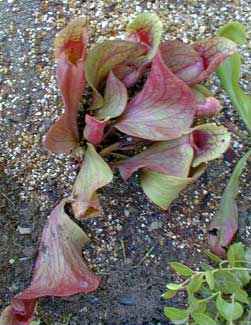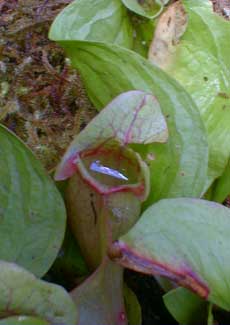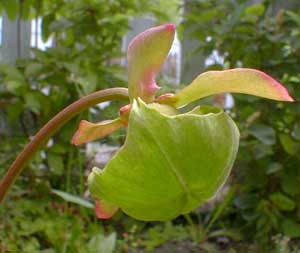
Carolina Mountain
Veined Purple Pitcher Plant;
aka, Huntsman's Cups,
Sidesaddle Flytrap, or
Frog's Britches
"Then with water fill the pitcher
Wreathed about with classic fables."
-Henry Wadsworth Longfellow
(1807-1882)
(1807-1882)
 The first photo from September (2003) is a species variant of the Carolina Mountain Purple Pitcher Plant. It was designated by the grower as Sarracenia purpurea ssp venosua var montana 'Carolina 3.' The one we have was cultivated by Elaine Bassett & Gerry Addington of Courting Frogs Nursery in Stanwood, Washington.
The first photo from September (2003) is a species variant of the Carolina Mountain Purple Pitcher Plant. It was designated by the grower as Sarracenia purpurea ssp venosua var montana 'Carolina 3.' The one we have was cultivated by Elaine Bassett & Gerry Addington of Courting Frogs Nursery in Stanwood, Washington.This has much larger pitchers than the usual veined subspecies, & is typical of the races of the veined subspecies found further south in its range. The variant montana is extremely rare in the wild, having always been restricted to a few areas of the Carolinas & Georgia, but 'Carolina 3' is a tissue-cultured cultivated variety, so obtaining these for the garden does not put pressures on the endangered wild populations.
The montana variant is sometimes available from breeders under the cultivated name "Carolina Mountain," though one wonders if some of these aren't hybridized with other races or even other species of pitcher plants. The large size & wavy edges of this variant's pitchers make it especially appealing.
 The third photo shows the flower of "Carolina 3" Veined Purple Pitcher in July. The nodding flowers on foot & a half long stems are quite long-lasting & range from bright red to pink & green. The round mound of this bloom has lent the genus the additional folk-name Biscuit Flowers.
The third photo shows the flower of "Carolina 3" Veined Purple Pitcher in July. The nodding flowers on foot & a half long stems are quite long-lasting & range from bright red to pink & green. The round mound of this bloom has lent the genus the additional folk-name Biscuit Flowers.Regional races can look quite distinct, & specimens from different breeders vary a lot. Of many forms to be had in the marketplace, 'Carolina 3' & probably most true montana variants have the more extravagant wavy-edged pitchers with full-wide mouths. The regular purple variant has brighter veins but much smaller entrances to the pitchers.
Tall upright pitcher plants of such species as Sarracenia leucophylla entice flying insects, but the prostrate Veined Purple pitchers tempt crawling insects & even small slugs & snails. In this lying-backward position with its lid tipped further back than most pitcher plants, the pitchers actually do fill up with rainwater, as can be seen in the second photo from October (2005). Insects that crawl inside drown. When I open up a spent pitcher-leaf, it is evident that in our garden it is mainly devouring sowbugs & small beetles, vs. the taller pitchers that loaded with dead flies & moths.
 A robust carniverous plant, it is easily grown in our Puget Sound climate. It wants persistent boggy conditions year-round & must never dry out. It produces the majority of its growth summer & autumn, then its specialized leaves will blacken as winter progresses. Spent leaves should be trimmed out for looks & so as not to crowd fresh leaves.
A robust carniverous plant, it is easily grown in our Puget Sound climate. It wants persistent boggy conditions year-round & must never dry out. It produces the majority of its growth summer & autumn, then its specialized leaves will blacken as winter progresses. Spent leaves should be trimmed out for looks & so as not to crowd fresh leaves.All pitcher plants need a very gentle overhead watering. The Veined Purple needs overhead watering more than most, since it is not apt to be able to catch food if its pitchers are empty of water. Other pitcher plants rely more on interior hairs that hook downward into the funnel, so that insects that get inside can crawl downward easily but not back up.
For relying on the drowning technique, Purple Pitcher Plants are rather less effective as an insect trap than most in the genus, though I've opened worn-out pitchers that were packed full of woodlouse husks, so its slightly inferior method is nevertheless sufficient.
The genus is named for the first person to describe the Purple Pitcher Plant, Dr. Michel Sarrazin (1659-1734), botanist, zoologist & Quebec's first surgeon, shown in the portrait.
Sarracenia leucophylla x S. rubra x psittacina,
Ladies-in-Waiting Pitcher Plant